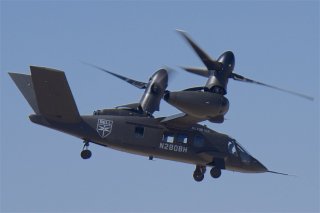Fly by Drone: Can the V-280 Helicopter Become Fully Autonomous?
Unmanned capability may increasingly become a standard feature in platforms that aren’t even primarily intended for use as drones.
Here's What You Need to Know: The V-280 takes its name from its cruising speed of 280 knots (320 miles per hour), nearly twice maximum speed of an average military helicopter. It also boasts a vastly greater combat range of 520 to 920 miles, depending on loadout.
In December 2019, Bell had its V-280 Valor tilt rotor demonstrator aircraft perform an entire test mission drive driven according to computer algorithms—almost without any human inputs.
To be exact, the V-280’s software individually performed all of the tasks that might be expected of it in a routine non-combat mission without human input, but a human operator was onboard and the helicopter during the transitions between each tasks. Those tasks include:
1) Taking off vertically in “helicopter” mode, with the V-280’s propellers tilted upward to serve as rotors.
2) Transitioning the rotors to horizontally oriented “airplane mode” with greater speed and fuel efficiency.
3) Cruising towards multiple waypoints in horizontal flight mode
4) Loitering by flying in circles above a waypoint
5) Tilting the rotor back to vertical and landing helicopter-style at a destination.
If further tests are undertaken—none are presently schedule—they would likely seek to seamlessly integrate those tasks in one continuous autonomous flight operation.
What’s especially striking is that the tech demonstrator isn’t even primarily intended to serve as an unmanned system. It’s competing with the Sikorsky-Boeing SB>1 Defiant compound-rotor helicopter in the Army’s Future Vertical Lift competition, particularly the Future Long Range Assault Aircraft program which seeks a successor to workhorse UH-60 Blackhawk helicopter used both for cargo missions and to deliver troops into combat.
FVL is one of the Army’s priorities in its Big Six modernization program to reequip its forces for twenty-first century warfare.
Like for the Optionally Manned Fighting Vehicle intended to replace the Army’s M2 Bradley infantry fighting vehicles (recently canceled but likely be rebooted soon), Bell’s tests suggest that unmanned capability may increasingly become a standard feature in platforms that aren’t even primarily intended for use as drones.
Despite being more expensive and historically crash-prone, tiltrotors ideally combine the maneuverability and vertical takeoff and landing abilities of a helicopter with the superior speed, high-altitude performance and fuel efficiency of a fixed-wing airplane. You can see a V-280 in both flight modes here.
The V-280 takes its name from its cruising speed of 280 knots (320 miles per hour), nearly twice maximum speed of an average military helicopter. It also boasts a vastly greater combat range of 520 to 920 miles, depending on loadout.
By contrast, the V-280’s competitor, the SB>1 is a more compact helicopter with compound rotor blades stacked on top of each other. Compared to the V-280s, it’s projected to cruise a bit slower (250 knots) and significantly less far (280 miles), but in theory would be more maneuverable in tight quarters and cost less to procure and operate.
However, the V-280 began test flights on December 2017, whereas the first SB>1 flight only took place on March 21, 2019 due to technical problems. Meanwhile, the V-280 has chalked up 160 flight hours.
Yet while Bell’s enthused about how well advanced the unmanned flight testing had proceeded, Army aviation modernization director Brig. Gen. Wally Rugen reportedly threw cold water on the notion that unmanned operation would show up in early FVL aircraft according to Breaking Defense.
“It’ll be a very tall order to get it into Increment 1,” he said, referring to the initial batch of production FVL aircraft due in the early 2030s. “We’ll have it in another spiral [upgrade cycle] for sure.”
After all, it’s one thing to fly unmanned on a routine delivery mission. It’s another to perform complex combat tasks such inserting into or extracting personnel from constricted landing zones possibly at night or in inclement weather, evading enemy fire and sensors, searching an area on a rescue or reconnaissance missions, and attacking targets with weapons. If desired, such capabilities would require far more advanced algorithms.
There may even be reservations about entrusting living soldiers for transportation to a fully autonomous aircraft.
So what exactly would be the concept of operations behind an optionally unmanned V-280? Unlike many unmanned systems which are cheap enough to be treated as relatively expendable, a high-performance tilt-rotor transport simply can’t be sacrificed like cannon fire.
Nonetheless, an unmanned tiltrotor might be used to perform routine cargo delivery missions to forward outposts without having to keep a rescue crew on standby in the event of an accident or combat loss.
If more advanced algorithms for operating in a combat environment can be developed, an autonomous option could make employing a tiltrotor on riskier attack or reconnaissance missions more appealing without having to worry about losing a human crew alongside the expensive aircraft.
Thus, Bell’s achievement with the V-280 helicopters is an indicator as to how unmanned capability is growing ubiquitous in modern military systems—but also the limitations and technical problems that will need to be addressed before autonomous systems can begin replacing traditionally manned combat platforms such as helicopters, tanks, and submarines.
Sébastien Roblin holds a Master’s Degree in Conflict Resolution from Georgetown University and served as a university instructor for the Peace Corps in China. He has also worked in education, editing, and refugee resettlement in France and the United States.
This article first appeared in December 2019 and is being reprinted due to reader interest.
Image: Bell Textron Inc.

